Netskope IPSec with Versa Director
This guide explains the network and system configuration for the Versa Operating System (VOS) using Versa Director and the Netskope Security Cloud Platform using Secure Web Gateway (NG-SWG).
This document is for experienced network and system administrators who are responsible for configuring and managing public and private cloud infrastructure. It is presumed that admins are aware of virtualization concepts, technologies, and setup of network devices.
Supported Software Versions
Versa Director: 20.2.1
Versa Analytics: 20.2.1
Versa VOS: 20.2.1
Netskope R73+
Description
Versa SD-WAN Implementation where internet traffic needs to be sent to Netskope’s Next Generation Secure Web Gateway, this guide captures the configuration of the Versa Operating System (VOS) using Versa Director (Orchestrator), and the required Netskope configurations.
Netskope interoperability with Versa branches can be achieved using Site-to-Site IPSec VPN or GRE from the Versa WAN-Edge device to a Netskope Next Generation Secure Web Gateway (NG-SWG) based on parameters provided by Netskope.
Netskope and Versa support both IKEv2/IPSec and GRE-based tunnels.
Topology
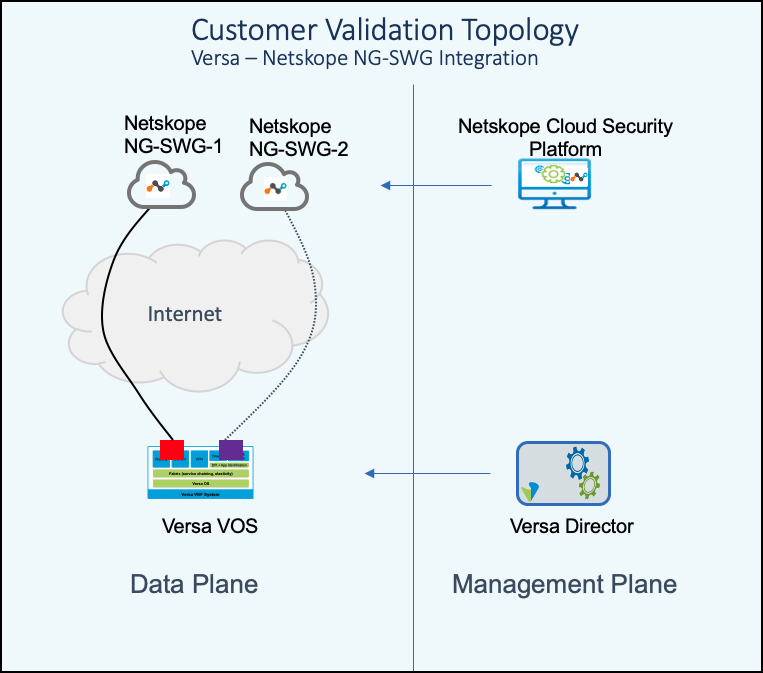 |
Configuration
To establish an IPSec Tunnel, this information is required.
SWG Parameters | Versa Parameters | Description |
|---|---|---|
Source Identity | IKE – Peer IP | Peer IP to establish IPsec |
Primary POP/Secondary POP | Local ID – IP | IKE |
Primary POP/Secondary POP | Remoted ID – IP Address | |
PSK | PSK | Pre-shared Key |
Policy Example: Match HTTP and HTTPS | Match policy for Policy based tunnel | |
IKE Version V2 | IKE Version V2 |
In Versa Director, go to Workflows.
Expand Template then click Templates.
Click
 to add a new workflow template.
to add a new workflow template.
In the General, Interfaces, and Routing tabs, configure your basic information.
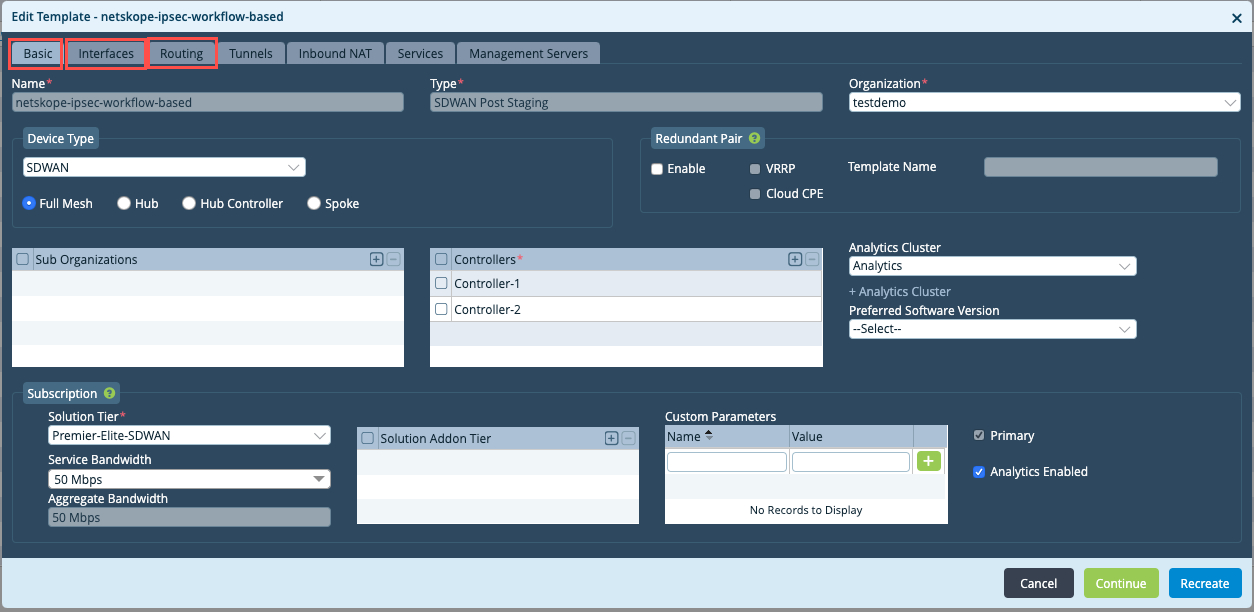
Click the Tunnels tab.
Under Split Tunnels, configure the DIA tunnel from your LAN VR for DNS queries.

In the Site to Site Tunnels section:
Enter an appropriate name for the tunnel.
For the Peer Type, select Unmanaged.
Select a WAN network.
Select customer LAN VRF.
Select + Add New from the Vpn Profile dropdown to configure a new VPN profile.
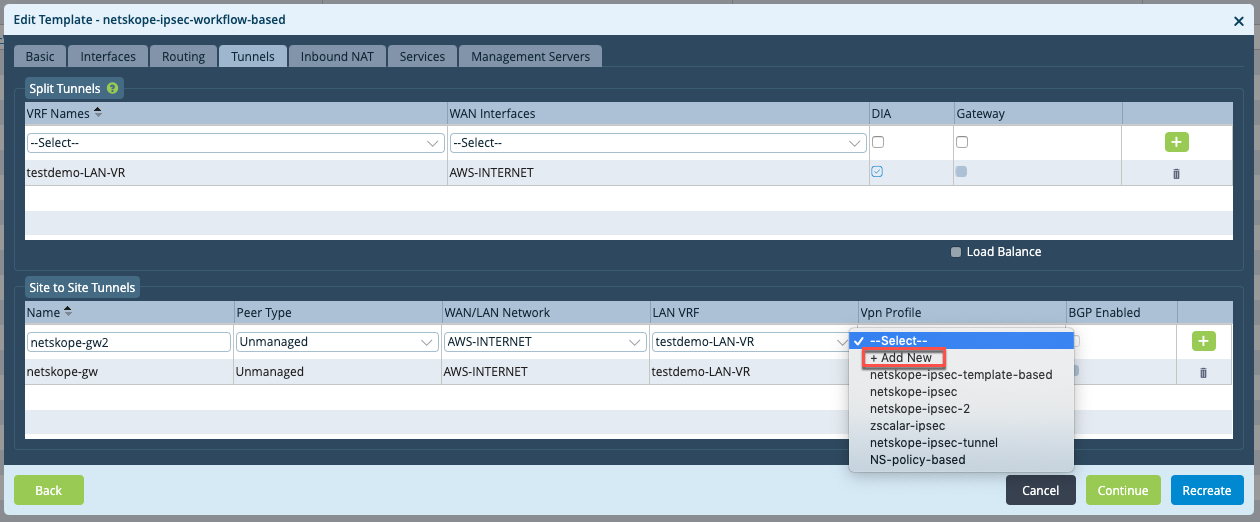
In the Create Authentication Profile window:
Configure appropriate VPN Profile Name.
Select IKE Version v2.
Select IKE Transform aes128-sha512.
Select IPSec Transform esp-aes128-sha512.
Select No. of tunnels as 2.
Configure a Peer Auth PSK Key.
Configure Netskope WAN IP as Peer Auth IP Identifier Identity.
Select Tunnel Config as Policy Based.
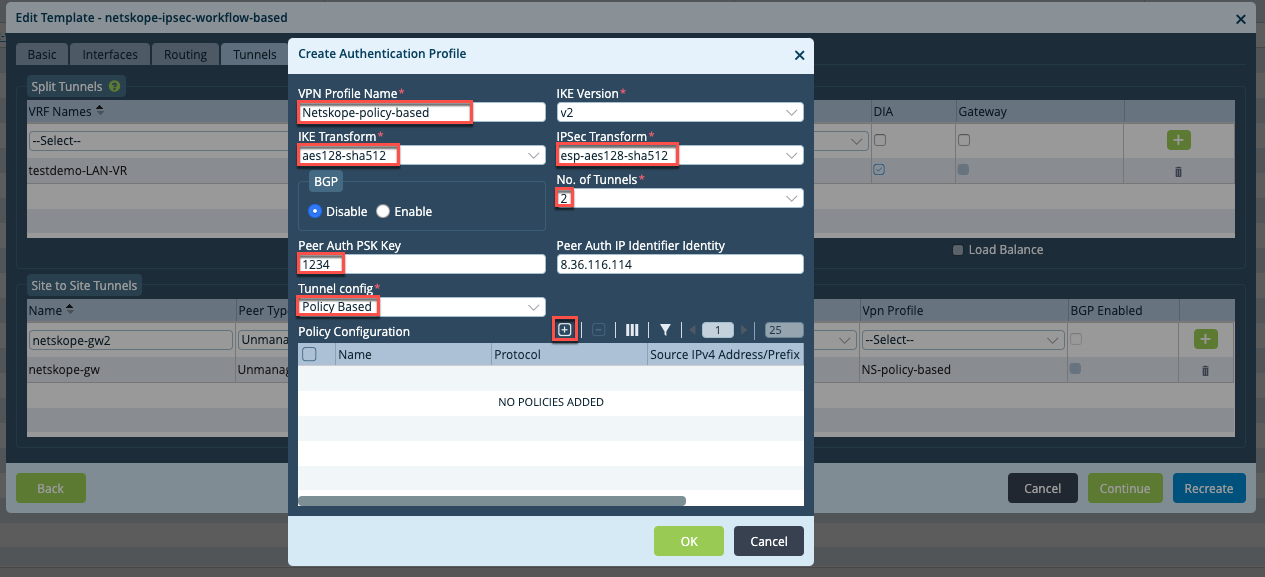
In Policy Configuration, click
 to add two new policies:
to add two new policies:Add a policy to accept HTTP traffic, and click OK.
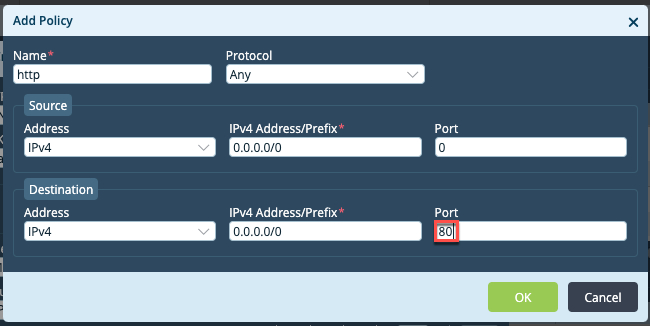
Add a another policy to accept HTTPS traffic, and click OK.
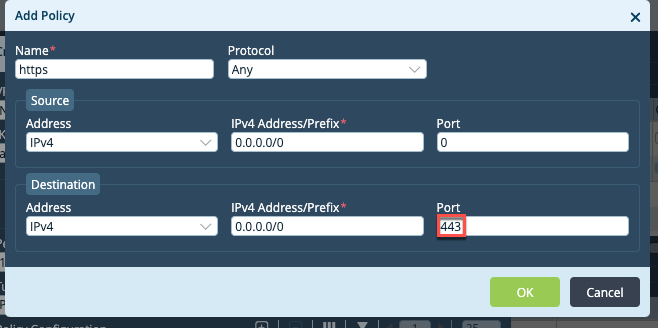
Click OK.

Click the green
 for the tunnel configuration to add the tunnel.
for the tunnel configuration to add the tunnel.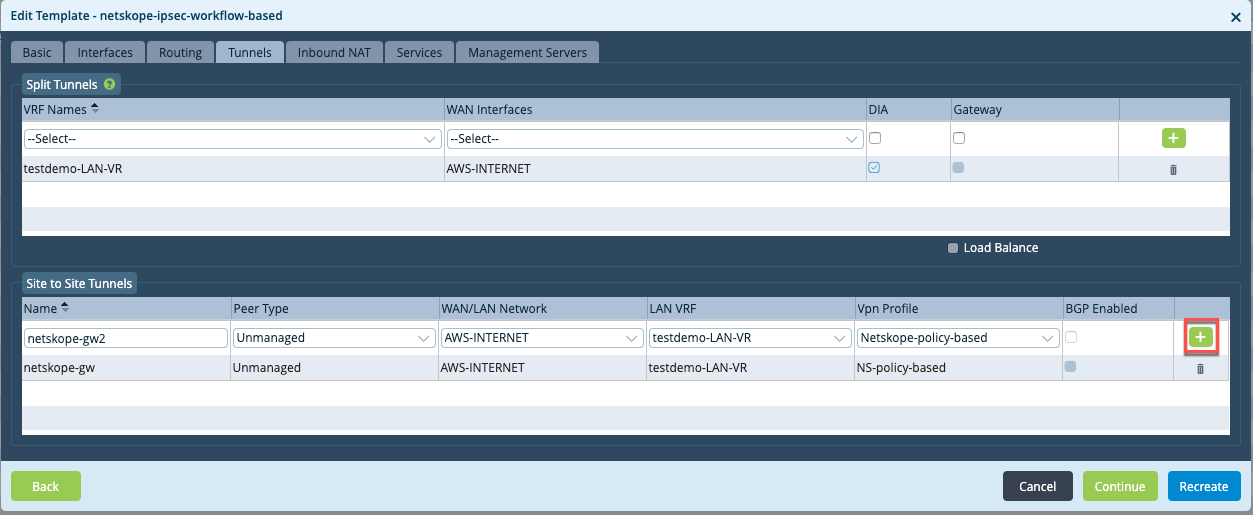
Configure the Inbound NAT, Services, and Management Servers tabs per your requirements, and clickRecreate to create workflow template.
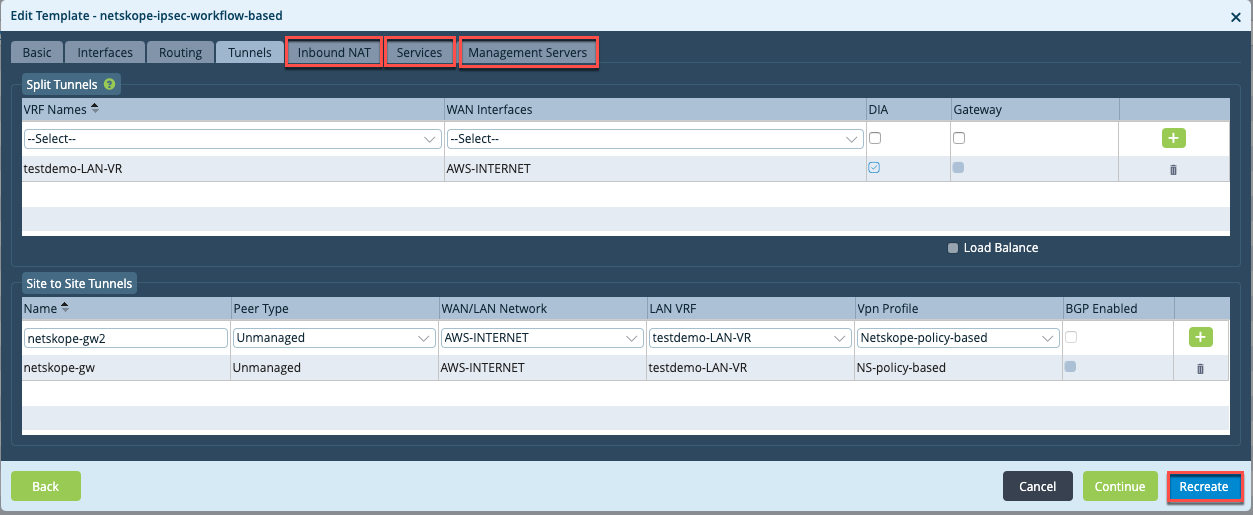
Go to Configuration > Templates > Device Templates, and select the template you created in the previous step to enter the template configuration view.
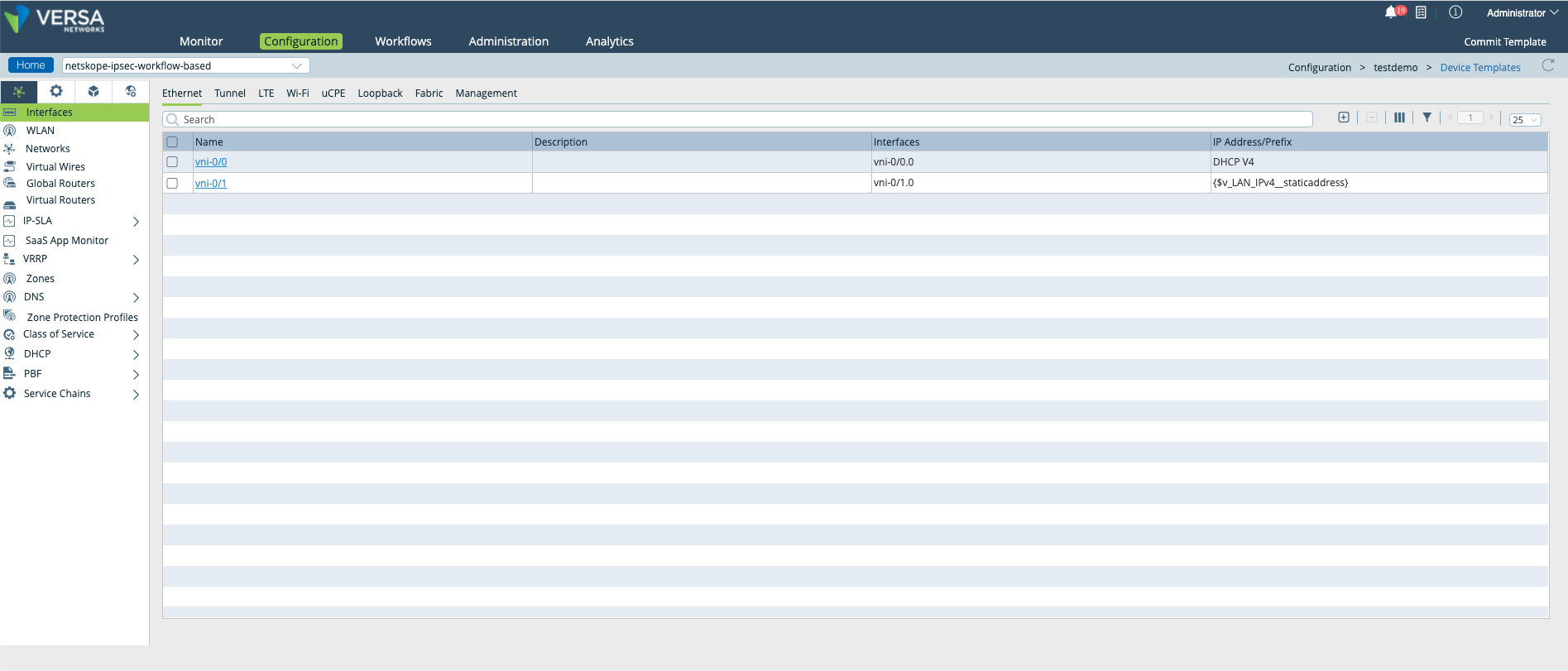
Go to Services > IPSec > VPN Profiles. Because 2 tunnels were selected, two separate VPN profiles have been created:
Netskope-gw1andNetskope gw2.Click
Netskope-gw1to edit, and click the IKE tab.Change the DH group to Diffie-Hellman-Group 14 2048.
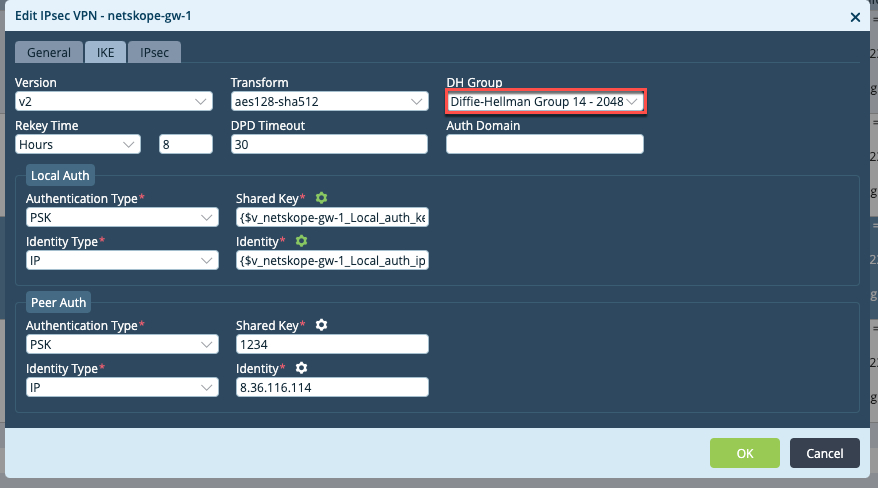
Click the IPSec tab, and change the DH group to Diffie-Hellman-Group 14 2048, and then click OK.

Click
Netskope-gw2, and modify the Peer IP to that of the backup tunnel endpoint.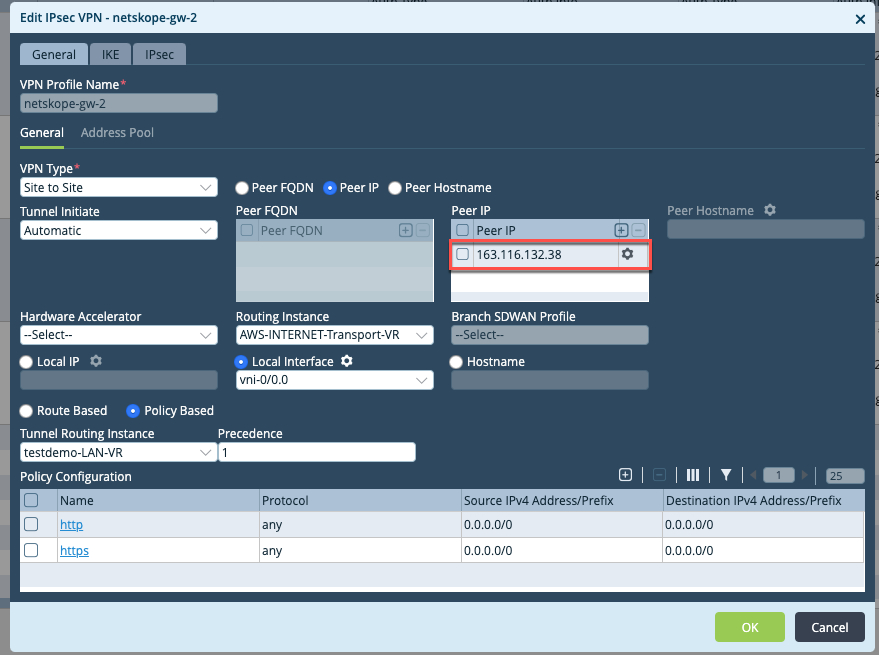
Click the IKE tab, and change the DH group to Diffie-Hellman-Group 14 2048, and Peer Auth Identity to the backup tunnel endpoint.
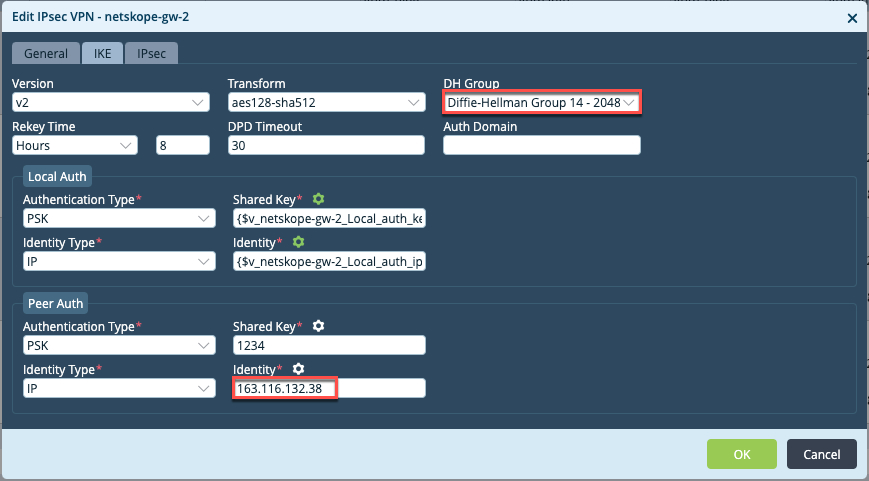
Click the IPsec tab, and change the DH group to Diffie-Hellman-Group 14 2048, and then click OK.

Go to Workflows > Devices > Devices, and click OK to add a device template based on the workflow template created in previous step. Enter the basic information under Basic > Device Service template and tabs.
Click the Tunnel Information tab, and verify that tunnel information is auto-populated. If some information has to be provided by the user, update the information.

In the Bind Data section, enter your bind data information, and click OK:
netskope-gw-1_Local_auth_ip_identifier__IKELIdentifieris the Versa source WAN IP for the primary tunnel. Copy the local auth identifier to add it in the Netskope UI.netskope-gw-1_Local_auth_key__IKELKeyis the pre-shared key for the primary tunnel. Copy the auth key to add it in the Netskope UI.netskope-gw-2_Local_auth_ip_identifier__IKELIdentifieris the Versa source WAN IP for backup tunnel. Copy the local auth identifier to add it in the Netskope UI.netskope-gw-2_Local_auth_key__IKELKeyis the pre-shared key for the backup tunnel. Copy the auth key to add it in the Netskope UI.
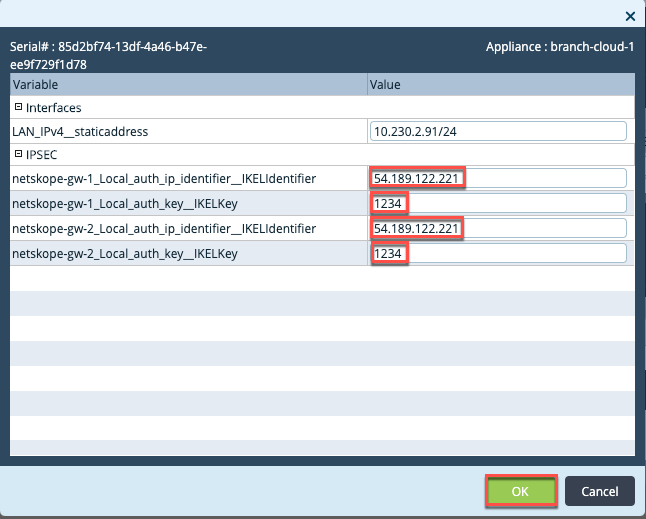
Deploy the device workflow configuration and onboard the device.
Verification
Go to the Monitor tab, select Organization > Devices, and select a device.
Click Services > IPSEC > IPSEC Security Association, and select
netskope-gw1from the drop-down list to verify the primary tunnel status.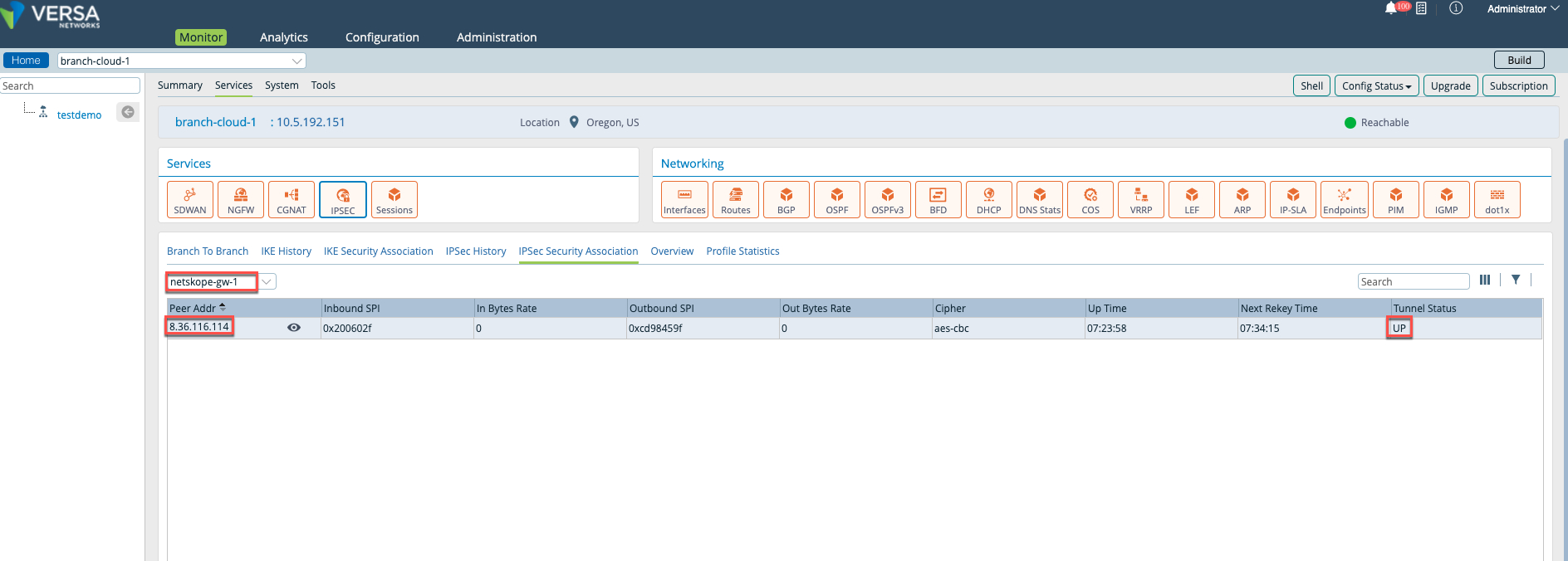
Select
netskope-gw-2to verify backup tunnel status.
To create the IPSec tunnels for Versa Director in the Netskope UI:
Go to Settings > Security Cloud Platform > IPSec.
Click Add New Tunnel.
In the Add New IPSec Tunnel window:
Tunnel Name: Enter a name for the IPSec tunnel.
Source IP Address: (Optional) Enter the source peer IP address (i.e., exit public IP) of the Versa router that Netskope will receive packets from. Netskope identifies traffic belonging to your organization through your router or firewall IP addresses.
Source Identity: Enter the
local-auth-info id-stringfrom the VOS configuration. The router or firewall uses the source identity for authentication during Internet Key Exchange (IKE).Primary Netskope POP: Select the primary Netskope point of presence (POP) closest to you, and copy the IPSec Gateway IP address. You need this information to establish the primary IPSec tunnel on your Versa router. For optimal performance, Netskope recommends using the geographically closest POPs and configuring at least two tunnels for each egress location in your network.
Failover Netskope POP: Select the backup Netskope POP closest to you, and copy the IPSec Gateway IP address. You need this information to establish the backup IPSec tunnel on your Versa router. For optimal performance, Netskope recommends using the geographically closest POPs and configuring at least two tunnels for each egress location in your network.
Pre-Shared Key (PSK): Enter the pre-shared key that both sides of the tunnel will use to authenticate one another. The PSK must be unique for each tunnel.
Encryption Cipher: Select an encryption algorithm for the IPSec tunnel.
Maximum Bandwidth: Enter the maximum bandwidth for the IPSec tunnel. The tunnel size can be up to 1 Gbps. To enable the 1 Gbps option, contact your Sales Representative.
Advanced Settings: Click to view the following options.
Rekey: Select to rekey SAs when they expire. For Versa Director, Netskope recommends deselecting this option.
Reauthentication: Select to create new IKE and IPSec SAs when they expire. For Versa Director, Netskope recommends deselecting this option.

Click Add.
To view the IPSec tunnel information, click the tunnel name. If the IPSec tunnel configuration is successful, the Status will be  Up.
Up.
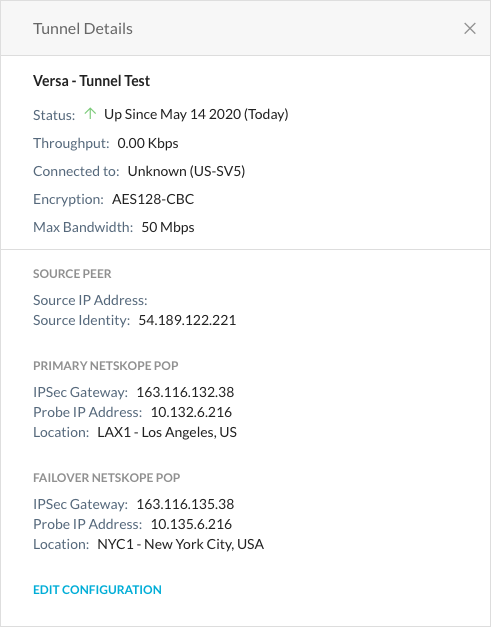
Below is a sample CLI IPSec tunnel configuration for Versa Director:
admin@branch-cloud-1-cli> show configuration orgs org-services testdemo ipsec vpn-profile netskope-gw-1
vpn-type site-to-site;
local-auth-info {
auth-type psk;
id-type ip;
key 1234;
id-string 54.189.122.221;
}
local {
interface-name vni-0/0.0;
}
routing-instance AWS-INTERNET-Transport-VR;
tunnel-routing-instance testdemo-LAN-VR;
tunnel-initiate automatic;
ipsec {
fragmentation pre-fragmentation;
force-nat-t disable;
transform esp-aes128-sha512;
mode tunnel;
pfs-group mod14;
anti-replay enable;
life {
duration 28800;
}
}
ike {
version v2;
group mod14;
transform aes128-sha512;
lifetime 28800;
dpd-timeout 30;
}
peer-auth-info {
auth-type psk;
id-type ip;
key 1234;
id-string 8.36.116.114;
}
peer {
address [ 8.36.116.114 ];
}
rule http {
protocol any;
src {
inet 0.0.0.0/0;
port 0;
}
dst {
inet 0.0.0.0/0;
port 80;
}
}
rule https {
protocol any;
src {
inet 0.0.0.0/0;
port 0;
}
dst {
inet 0.0.0.0/0;
port 443;
}
}
[ok][2020-05-15 11:58:36]
admin@branch-cloud-1-cli>
admin@branch-cloud-1-cli> show configuration orgs org-services testdemo ipsec vpn-profile netskope-gw-2
vpn-type site-to-site;
local-auth-info {
auth-type psk;
id-type ip;
key 1234;
id-string 54.189.122.221;
}
local {
interface-name vni-0/0.0;
}
routing-instance AWS-INTERNET-Transport-VR;
tunnel-routing-instance testdemo-LAN-VR;
tunnel-initiate automatic;
ipsec {
fragmentation pre-fragmentation;
force-nat-t disable;
transform esp-aes128-sha512;
mode tunnel;
pfs-group mod14;
anti-replay enable;
life {
duration 28800;
}
}
ike {
version v2;
group mod14;
transform aes128-sha512;
lifetime 28800;
dpd-timeout 30;
}
peer-auth-info {
auth-type psk;
id-type ip;
key 1234;
id-string 163.116.132.38;
}
peer {
address [ 163.116.132.38 ];
}
rule http {
protocol any;
src {
inet 0.0.0.0/0;
port 0;
}
dst {
inet 0.0.0.0/0;
port 80;
}
}
[ok][2020-05-15 11:59:09]
admin@branch-cloud-1-cli>
admin@branch-cloud-1-cli> show configuration orgs org-services testdemo ipsec vpn-profile netskope-gw-1 | display set set orgs org-services testdemo ipsec vpn-profile netskope-gw-1 vpn-type site-to-site set orgs org-services testdemo ipsec vpn-profile netskope-gw-1 local-auth-info set orgs org-services testdemo ipsec vpn-profile netskope-gw-1 local-auth-info auth-type psk set orgs org-services testdemo ipsec vpn-profile netskope-gw-1 local-auth-info id-type ip set orgs org-services testdemo ipsec vpn-profile netskope-gw-1 local-auth-info key 1234 set orgs org-services testdemo ipsec vpn-profile netskope-gw-1 local-auth-info id-string 54.189.122.221 set orgs org-services testdemo ipsec vpn-profile netskope-gw-1 local set orgs org-services testdemo ipsec vpn-profile netskope-gw-1 local interface-name vni-0/0.0 set orgs org-services testdemo ipsec vpn-profile netskope-gw-1 routing-instance AWS-INTERNET-Transport-VR set orgs org-services testdemo ipsec vpn-profile netskope-gw-1 tunnel-routing-instance testdemo-LAN-VR set orgs org-services testdemo ipsec vpn-profile netskope-gw-1 tunnel-initiate automatic set orgs org-services testdemo ipsec vpn-profile netskope-gw-1 ipsec fragmentation pre-fragmentation set orgs org-services testdemo ipsec vpn-profile netskope-gw-1 ipsec force-nat-t disable set orgs org-services testdemo ipsec vpn-profile netskope-gw-1 ipsec transform esp-aes128-sha512 set orgs org-services testdemo ipsec vpn-profile netskope-gw-1 ipsec mode tunnel set orgs org-services testdemo ipsec vpn-profile netskope-gw-1 ipsec pfs-group mod14 set orgs org-services testdemo ipsec vpn-profile netskope-gw-1 ipsec anti-replay enable set orgs org-services testdemo ipsec vpn-profile netskope-gw-1 ipsec life duration 28800 set orgs org-services testdemo ipsec vpn-profile netskope-gw-1 ike version v2 set orgs org-services testdemo ipsec vpn-profile netskope-gw-1 ike group mod14 set orgs org-services testdemo ipsec vpn-profile netskope-gw-1 ike transform aes128-sha512 set orgs org-services testdemo ipsec vpn-profile netskope-gw-1 ike lifetime 28800 set orgs org-services testdemo ipsec vpn-profile netskope-gw-1 ike dpd-timeout 30 set orgs org-services testdemo ipsec vpn-profile netskope-gw-1 peer-auth-info set orgs org-services testdemo ipsec vpn-profile netskope-gw-1 peer-auth-info auth-type psk set orgs org-services testdemo ipsec vpn-profile netskope-gw-1 peer-auth-info id-type ip set orgs org-services testdemo ipsec vpn-profile netskope-gw-1 peer-auth-info key 1234 set orgs org-services testdemo ipsec vpn-profile netskope-gw-1 peer-auth-info id-string 8.36.116.114 set orgs org-services testdemo ipsec vpn-profile netskope-gw-1 peer set orgs org-services testdemo ipsec vpn-profile netskope-gw-1 peer address [ 8.36.116.114 ] set orgs org-services testdemo ipsec vpn-profile netskope-gw-1 rule http protocol any set orgs org-services testdemo ipsec vpn-profile netskope-gw-1 rule http src inet 0.0.0.0/0 set orgs org-services testdemo ipsec vpn-profile netskope-gw-1 rule http src port 0 set orgs org-services testdemo ipsec vpn-profile netskope-gw-1 rule http dst inet 0.0.0.0/0 set orgs org-services testdemo ipsec vpn-profile netskope-gw-1 rule http dst port 80 set orgs org-services testdemo ipsec vpn-profile netskope-gw-1 rule https protocol any set orgs org-services testdemo ipsec vpn-profile netskope-gw-1 rule https src inet 0.0.0.0/0 set orgs org-services testdemo ipsec vpn-profile netskope-gw-1 rule https src port 0 set orgs org-services testdemo ipsec vpn-profile netskope-gw-1 rule https dst inet 0.0.0.0/0 set orgs org-services testdemo ipsec vpn-profile netskope-gw-1 rule https dst port 443 [ok][2020-05-15 11:59:45]
admin@branch-cloud-1-cli> show configuration orgs org-services testdemo ipsec vpn-profile netskope-gw-2 | display set set orgs org-services testdemo ipsec vpn-profile netskope-gw-2 vpn-type site-to-site set orgs org-services testdemo ipsec vpn-profile netskope-gw-2 local-auth-info set orgs org-services testdemo ipsec vpn-profile netskope-gw-2 local-auth-info auth-type psk set orgs org-services testdemo ipsec vpn-profile netskope-gw-2 local-auth-info id-type ip set orgs org-services testdemo ipsec vpn-profile netskope-gw-2 local-auth-info key 1234 set orgs org-services testdemo ipsec vpn-profile netskope-gw-2 local-auth-info id-string 54.189.122.221 set orgs org-services testdemo ipsec vpn-profile netskope-gw-2 local set orgs org-services testdemo ipsec vpn-profile netskope-gw-2 local interface-name vni-0/0.0 set orgs org-services testdemo ipsec vpn-profile netskope-gw-2 routing-instance AWS-INTERNET-Transport-VR set orgs org-services testdemo ipsec vpn-profile netskope-gw-2 tunnel-routing-instance testdemo-LAN-VR set orgs org-services testdemo ipsec vpn-profile netskope-gw-2 tunnel-initiate automatic set orgs org-services testdemo ipsec vpn-profile netskope-gw-2 ipsec fragmentation pre-fragmentation set orgs org-services testdemo ipsec vpn-profile netskope-gw-2 ipsec force-nat-t disable set orgs org-services testdemo ipsec vpn-profile netskope-gw-2 ipsec transform esp-aes128-sha512 set orgs org-services testdemo ipsec vpn-profile netskope-gw-2 ipsec mode tunnel set orgs org-services testdemo ipsec vpn-profile netskope-gw-2 ipsec pfs-group mod14 set orgs org-services testdemo ipsec vpn-profile netskope-gw-2 ipsec anti-replay enable set orgs org-services testdemo ipsec vpn-profile netskope-gw-2 ipsec life duration 28800 set orgs org-services testdemo ipsec vpn-profile netskope-gw-2 ike version v2 set orgs org-services testdemo ipsec vpn-profile netskope-gw-2 ike group mod14 set orgs org-services testdemo ipsec vpn-profile netskope-gw-2 ike transform aes128-sha512 set orgs org-services testdemo ipsec vpn-profile netskope-gw-2 ike lifetime 28800 set orgs org-services testdemo ipsec vpn-profile netskope-gw-2 ike dpd-timeout 30 set orgs org-services testdemo ipsec vpn-profile netskope-gw-2 peer-auth-info set orgs org-services testdemo ipsec vpn-profile netskope-gw-2 peer-auth-info auth-type psk set orgs org-services testdemo ipsec vpn-profile netskope-gw-2 peer-auth-info id-type ip set orgs org-services testdemo ipsec vpn-profile netskope-gw-2 peer-auth-info key 1234 set orgs org-services testdemo ipsec vpn-profile netskope-gw-2 peer-auth-info id-string 163.116.132.38 set orgs org-services testdemo ipsec vpn-profile netskope-gw-2 peer set orgs org-services testdemo ipsec vpn-profile netskope-gw-2 peer address [ 163.116.132.38 ] set orgs org-services testdemo ipsec vpn-profile netskope-gw-2 rule http protocol any set orgs org-services testdemo ipsec vpn-profile netskope-gw-2 rule http src inet 0.0.0.0/0 set orgs org-services testdemo ipsec vpn-profile netskope-gw-2 rule http src port 0 set orgs org-services testdemo ipsec vpn-profile netskope-gw-2 rule http dst inet 0.0.0.0/0 set orgs org-services testdemo ipsec vpn-profile netskope-gw-2 rule http dst port 80 [ok][2020-05-15 11:59:51] admin@branch-cloud-1-cli>